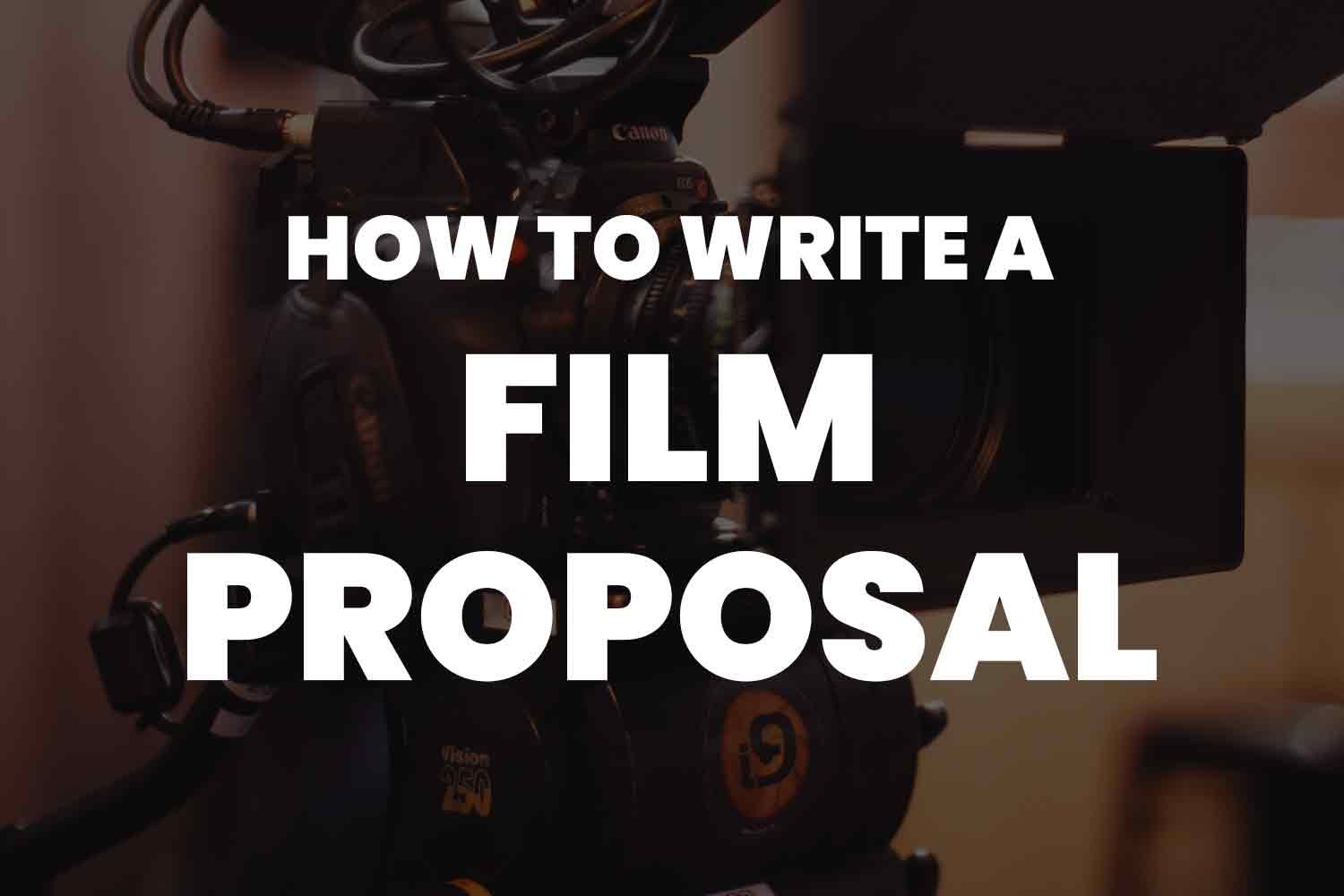A 9 Step Guide For Writing A Money Making Film Proposal
Film proposals are a critical part of the film industry and an essential tool for making a film. A well-crafted proposal can make the difference between a project that gets greenlit and one that languishes in development hell.
Whether you are an independent filmmaker looking to make your first feature or an experienced producer looking for your next project, learning how to write a compelling film proposal is essential.
In this blog post, I will guide you through writing a film proposal step by step. I will cover everything from defining your concept and researching your audience to crafting a logline and a synopsis.
Let's get started!
How To Write A Film Proposal?
Step 1: Define Your Concept
The first step in writing a film proposal is to define your concept. Your concept is the central idea that your film will revolve around. It will make your movie unique and stand out from the rest.
To define your concept, start by asking yourself the following questions:
What is the genre of your film?
What is the main theme of your film?
What is the story you want to tell?
Who is your target audience?
What is the message you want to convey through your film?
Once you have a clear idea of your concept, it's time to move on to the next step.
Step 2: Research Your Audience
Before you start writing your proposal, it's crucial to research your audience. Understanding your audience's needs, preferences, and expectations will help you tailor your proposal to their interests.
Start by studying the following:
Demographics: Who is your target audience? What is their age, gender, income level, and education level?
Psychographics: What are their values, beliefs, interests, and lifestyle?
Media consumption habits: What movies do they like to watch? How do they consume media?
Market trends: What are the current trends in the film industry? What types of films are popular right now?
By understanding your audience, you can create a proposal that appeals to them and has a higher chance of getting funded.
Step 3: Craft a Logline
A logline briefly summarizes your film's premise, capturing its essence in one or two sentences. It's the hook that will grab your audience's attention and make them want to know more.
A good logline should be clear, concise, and memorable. To craft a logline, follow these guidelines:
Keep it short: Stick to one or two sentences.
Focus on the main character: Your logline should be about your main character and their journey.
Include the conflict: What is the problem that your main character faces?
Convey the tone: Is your film a comedy, drama, or horror? Make sure your logline conveys the tone of your film.
Here's an example of a logline:
"When a young woman discovers that her boyfriend is actually a vampire, she must decide whether to join him in eternal life or risk everything to stay human."
Step 4: Write a Synopsis
A synopsis is a summary of your film's plot that outlines the major events and characters. It's a more detailed version of your logline that provides a clear picture of what your film is about.
A good synopsis should be around one to two pages long and should include the following elements:
Introduction: Introduce your main character and their world.
Inciting incident: What is the event that sets your story in motion?
Rising action: What are the obstacles your main character faces?
Climax: What is the turning point of your story?
Resolution: How does your story end?
Step 5: Include a Budget
A budget is a crucial component of any film proposal. It's a breakdown of the estimated costs of making your film, including pre-production, production, and post-production expenses.
It's important to be realistic and accurate when creating your budget, as investors will want to know exactly where their money is going. Your budget should include the following elements:
Pre-production costs: This includes expenses such as location scouting, casting, and script development.
Production costs: This includes expenses such as equipment rental, crew salaries, and location fees.
Post-production costs: This includes expenses such as editing, sound design, and visual effects.
Contingency fund: It's always a good idea to include a contingency fund if unexpected expenses arise.
Step 6: Provide a Marketing Plan
A marketing plan is a strategy for promoting your film and reaching your target audience. It's an essential component of your film proposal, as investors want to know how you plan to market and distribute your film.
Your marketing plan should include the following elements:
Target audience: Who is your film's target audience, and how do you plan to reach them?
Social media strategy: How will you use social media to promote your film?
Publicity strategy: How will you generate buzz and media coverage for your film?
Distribution plan: How do you plan to distribute your film, and what channels will you use?
Step 7: Add a Team Bios
Your film proposal can also include bios of key team members, such as the director, producer, and screenwriter.
These bios should highlight the team's experience and achievements in the film industry and show why they are the right people to bring your project to life. Be sure to include the following information in your bios:
Relevant experience: Highlight the team member's experience in the film industry, including any notable projects they have worked on.
Achievements: Include any awards or accolades the team member has received.
Skills and strengths: Highlight the team member's skills and strengths relevant to the project.
Education: Include any relevant education or training the team member has received.
Step 8: Polish Your Proposal
Once you have all the components of your film proposal, it's time to polish and refine it. Make sure your proposal is well-written, organized, and error-free. Here are some tips for polishing your proposal:
Edit for clarity and conciseness: Make sure your proposal is easy to read and understand.
Check for errors: Proofread your proposal for spelling and grammar errors. You can use a free grammar tool like Grammarly to automate this process.
Use formatting to your advantage: Use headings, bullet points, and other formatting tools to make your proposal easy to navigate.
Get feedback: Have someone else read your proposal and provide feedback. This can help you catch any errors or areas that need improvement.
Step 9: Submit Your Proposal
Once your proposal is complete, it's time to submit it to potential investors, studios, or production companies.
Follow submission guidelines carefully and tailor your proposal to the recipient's needs. Here are some tips for submitting your proposal:
Research potential investors: Look for investors or production companies that are a good fit for your project.
Personalize your submission: Address your submission to a specific person and include a personalized cover letter.
Be prepared for questions: Answer any questions or provide additional information about your project.
Follow up: If you are still waiting to hear back from the recipient within a reasonable time, follow up with a polite email or phone call.
Conclusion
Writing a film proposal is an essential part of the filmmaking process. It's a way to pitch your idea to potential investors and get your project off the ground.
Following these steps, you can create a comprehensive and compelling film proposal that stands out from the rest.
Remember to define your concept, research your audience, craft a logline and synopsis, include a budget and marketing plan, add team bios, and polish your proposal before submitting it.
With a well-crafted film proposal, you can turn your vision into a reality and bring your story to the big screen.
Frequently Asked Questions About Film Proposals (FAQs)
What is a film proposal?
A film proposal is a comprehensive document that outlines all the aspects of a film project, including its concept, plot, target audience, genre, budget, marketing strategy, and production timeline.
It is typically created to pitch a film idea to potential investors, producers, studios, or other stakeholders in the form of an elevator pitch or written form.
Why are film proposals important?
Film proposals are crucial for securing funding, resources, and support for a film project, such as a film grant or investments from potential funders.
They help convey the vision and potential of the project to stakeholders and demonstrate the film's viability as an investment.
What are the key elements of a film proposal?
A successful film proposal should include the following elements:
Logline: A one-sentence summary of the film's plot.
Synopsis: A brief overview of the film's story, including the main characters and key plot points.
Target audience: The intended viewers of the film, including demographic information.
Genre: The film's genre or combination of genres.
Director's statement: The director's vision for the film and their reasons for making it.
Cast and crew: A list of proposed or attached cast and crew members, with bios if available.
Budget: A detailed breakdown of the film's projected costs, including pre-production, production, and post-production expenses.
Marketing and distribution plan: Strategies for promoting the film and reaching the target audience.
Production timeline: A schedule outlining the various stages of the filmmaking process.
How do I create a compelling film proposal?
To create a compelling film proposal, focus on the following:
Be concise and clear: Ensure your proposal is easy to understand and avoids jargon.
Showcase your unique vision: Highlight what makes your film unique and engaging.
Be thorough: Include all the essential elements of a film proposal, demonstrating your understanding of the filmmaking process.
Present a realistic budget: Provide a well-researched budget that accurately reflects the film's needs and potential return on investment.
Proofread: Make sure your proposal is well-written, well-organized, and free of grammatical errors. Be sure to triple-check for any errors and make revisions based on feedback from others. You can use free grammar software like Grammarly to automate grammar checks.
How do I find funding for my film project?
Funding for film projects can come from various sources, including private investors, film production companies, film grants, crowdfunding platforms, and government-funded film agencies.
Research potential funding sources and tailor your proposal to each source's requirements and preferences.
How do I protect my film proposal's intellectual property?
Before sharing your film proposal with potential investors or collaborators, consider registering the script and treatment with a copyright office, a screenwriting guild, or other relevant organizations.
Consider using non-disclosure agreements (NDAs) when sharing your proposal with potential stakeholders.
Can I submit my film proposal to multiple parties at once?
Yes, you can submit your film proposal to multiple parties simultaneously. However, be aware of each potential investor or collaborator's specific submission guidelines and preferences.
Tailoring your proposal to fit each party's unique requirements and expectations is essential.
What should I avoid when creating a film proposal?
When creating a film proposal, avoid the following pitfalls:
Being overly vague: Provide enough detail to give potential stakeholders a clear understanding of your vision.
Overpromising: Be realistic about what you can deliver within the proposed budget and timeline.
Neglecting the target audience: Identify and describe the intended audience for your film and demonstrate how it will appeal to them.
Underestimating the importance of presentation: A well-organized, visually appealing, and professionally formatted proposal can significantly affect its perception.
Ignoring feedback: Be open to constructive criticism and use it to improve your proposal.
How long should a film proposal be?
The length of a film proposal can vary depending on the project's complexity and the intended audience's preferences. Generally, it should be concise yet thorough and range from 10 to 25 pages.
However, some components, such as a full script or detailed budget breakdown, may be provided as separate attachments.
Can I collaborate with others when creating a film proposal?
Yes, collaborating with others when creating a film proposal can be beneficial. Working with a team can help ensure your proposal covers all necessary elements, and different perspectives can enhance the proposal's overall quality.
Just be sure to clearly define roles and responsibilities within the team to avoid confusion and disagreements.






























